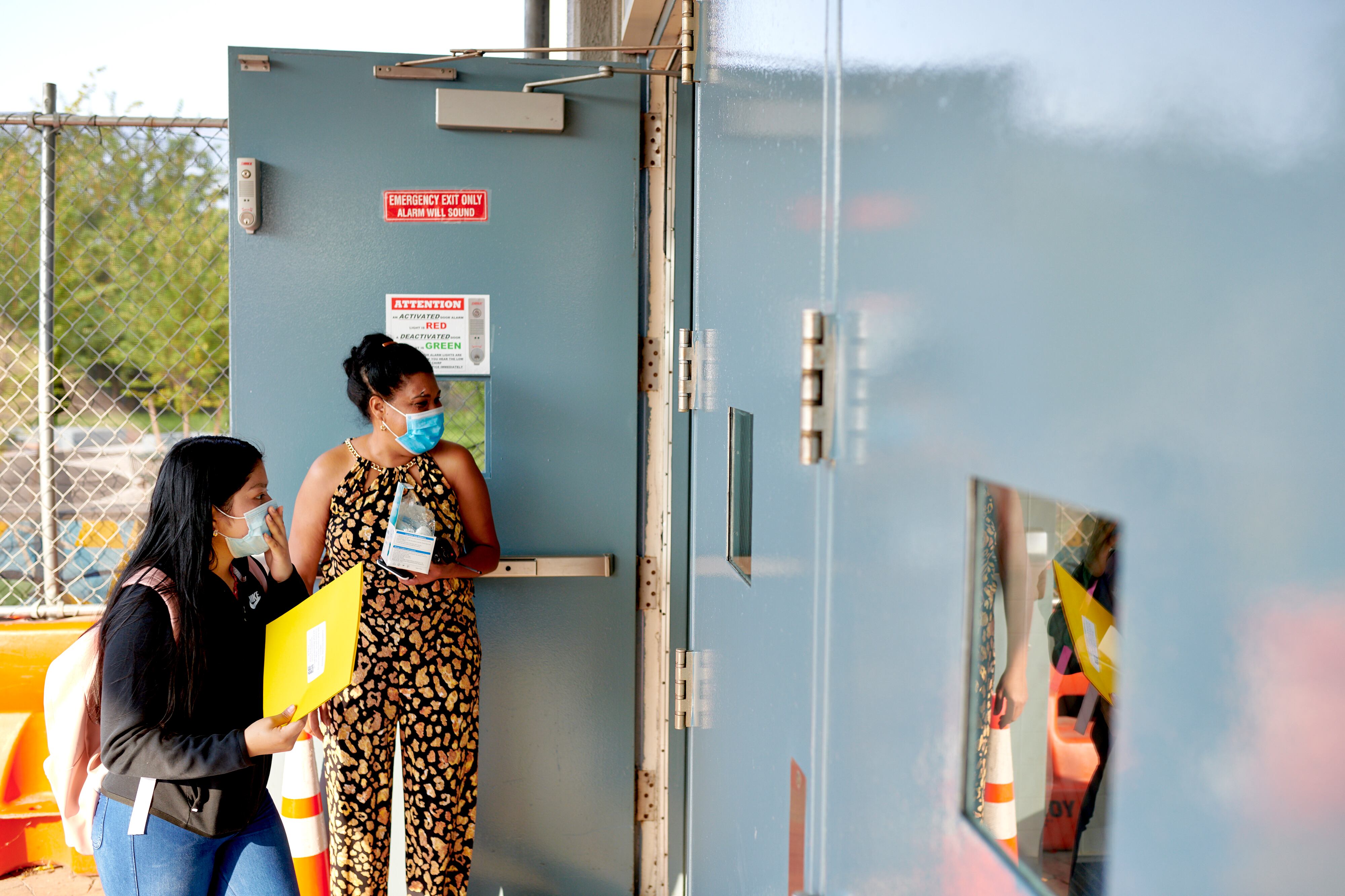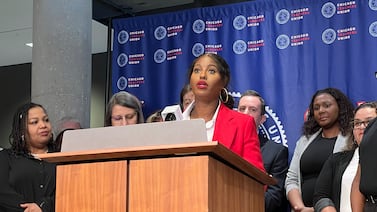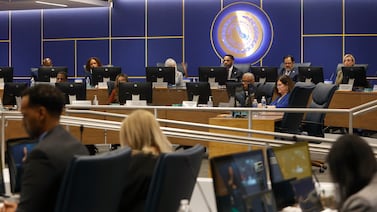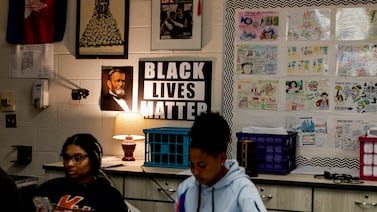Chalkbeat is a nonprofit news organization covering public education in communities across America. Subscribe to our free New York newsletter to keep up with NYC’s public schools.
A contentious proposal to lock the front entrances of New York City public school buildings won approval Wednesday evening by the city’s Panel for Educational Policy, a move that represents one of the biggest school security changes in recent years.
After a vigorous debate, the panel, whose majority is appointed by the mayor, greenlit a $43 million contract with Symbrant Technologies, Inc. that would equip schools with video equipment and buzzers monitored by school safety agents. The vote came after some panel members protested that they didn’t have enough information yet to evaluate the effectiveness of the initiative or potential downsides.
Those panel members — all of whom were appointed by borough presidents or parent leaders — pushed to table the contract vote for another month to gather more information. But a larger contingent of panel members, including all of the mayoral appointees present at the meeting, rejected that idea and pushed the proposal through Wednesday night, where it passed handily.
Locking entrances during the day has been a major priority of schools Chancellor David Banks, who has emphasized the need for new safety measures in the wake of last year’s school shooting in Uvalde, Texas, and a spate of other violent incidents near school buildings that have claimed the lives of young people in New York City. The proposal was included in the mayor’s preliminary budget last month, which indicated the building upgrades will cost about $78 million total.
School districts across the country have steadily “hardened” their campuses in recent years, with the vast majority of schools reporting that they control access to buildings, meaning that they are locked or monitored. But some experts said there is little rigorous evidence about whether those measures are effective, a point echoed by some panel members Wednesday night who said they wanted more information before making a decision.
Several members also pointed out that many of the most concerning violence targeting youth has taken place outside of schools.
“I want to make sure the solutions we’re providing actually solve for the issues we’re having,” said Tom Sheppard, a parent-elected panel member from the Bronx. “If the issues are happening around our schools, I have questions about whether this system of locking our doors will actually do anything to address that issue.”
An attempt at preventing school shootings
Education department officials declined to offer any examples of dangerous situations that would be prevented by the new buzzers and video intercoms, and much remains uncertain about how they will be implemented in practice, including the timeline for upgrading buildings. There are also downsides, including financial resources that could be spent elsewhere and the message it may send to visitors that they are not as welcome on campus.
“There are some people pushing really hard for some sort of safety measures,” panel member Kaliris Salas-Ramirez told Chalkbeat prior to the vote. “You want to be responsive, and you want to have some sort of cost-effective approach — and at the same time not do something that will harm our communities or make people feel iced out.”
City officials shared some details about the policy. Schools will not be expected to keep the main entrance locked during arrival and dismissal, or during emergency situations or drills, according to Jenna Lyle, an education department spokesperson. She also noted that school safety agents would not use the system to prevent parents from visiting the building to talk with school leaders.
Banks indicated that the proposal was an attempt to prevent school shootings. “That’s what this was an attempt to try to deal with,” he said.
The chancellor said he sympathized with the concerns of panel members who wanted more specifics and said he wouldn’t mind tabling the vote if necessary. But other panel members spoke up in favor of voting on the proposal Wednesday, citing its urgency.
“This comes down to one thing for me,” said Anthony Giordano, a recent mayoral appointee to the panel, also known as the PEP. “If something happened in this time where we voted no,” he said, “ I’m not going to be able to sleep because we as a PEP board didn’t do everything we can.”
School shootings are high-profile and horrifying — but they are also rare. There are fewer than 10 active-shooter events in schools across the entire country in most years. The most recent incident in which a child was killed inside a New York City public school building involved a student who stabbed two classmates in 2017, leaving one of them dead. Officials said it was the first fatal attack inside a city school in decades.
Educators have mixed reactions
Some educators said locking front doors makes sense, pointing to incidents where outsiders gained access to school buildings.
“At least you’re making a decision about whether this person has to come in,” said Darlene Cameron, principal at P.S. 63 in Manhattan. “It just gives the safety agents a little more power to be able to ask those questions.”
Robert Quintana, the principal of P.S. 28 in Queens and a representative for the principals union, said the issue of front door security was “personal” to him after Quintana had to physically subdue an intruder who entered his school earlier this year. In the wake of that incident, Quintana’s school was equipped with the door-locking and camera system, and has used it for the past four months.
“These common sense measures will certainly strengthen our first line of defense,” he said.
A spokesperson for the union that represents principals and other school administrators echoed that position, but also noted that they believe decisions about their use should be “at the principal’s discretion.” Education officials did not immediately respond to a question about whether school leaders would have any control over how the locking systems are used at their schools.
A spokesperson for the union that represents school safety agents did not return a request for comment.
Other educators were less enthusiastic and pointed to a slew of logistical complications. On many campuses, students arrive late throughout the morning and staff often leave for lunch, situations that would require school safety agents to repeatedly buzz people in throughout the day.
Plus, some school leaders said it’s impossible for school safety agents to know everyone who should have access to a building, especially on campuses that house multiple schools — raising questions about who would be prevented from entering a building and how safety agents will make that decision.
“If a building holds 3,000 kids, if even 1% come in later than the cutoff time, that’s 30 different times — and then you’ve got parents and deliveries,” said one Brooklyn high school principal who spoke on condition of anonymity. “Obviously, you read about school shootings and it’s scary for all of us, so everyone wants to do something. But mostly what we need to do is keep doing our jobs and not create a new obstacle.”
The principal also noted there have been circumstances when students seek refuge in a school building if they’re trying to escape danger off campus, a situation that could be complicated by a locked door. Banks previously said he shares that concern.
“Sometimes children find themselves in trouble on the streets … in many cases the only place that they know that they can run to for some level of safety is to come to the school,” he said in September. “We have to balance this idea around just even locking the front doors with ensuring a level of safety for all of our students.”
Some experts said the most effective approach to securing school buildings is having a staff member monitor the main entrance, which school safety agents are already expected to do. Adding buzzers would not likely act as a significant barrier particularly if the intruder is armed, though it could slow them down, said Brian Rhodes, a researcher at IPVM, a trade publication that focuses on security infrastructure.
“The best thing is to have more people who make it their business to find out why people are on school grounds to begin with,” he said. “If that fails, I don’t think intercoms and cameras will close the gap.”
Alex Zimmerman and Michael Elsen-Rooney cover NYC public schools. Contact Alex at azimmerman@chalkbeat.org. Contact Michael at melsen-rooney@chalkbeat.org.






